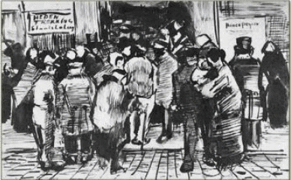This week the WAGER announces the release of the second volume of the Harvard Medical School Division on Addictions web initiative, Addictions in the Humanities. The aim of this initiative is to create a public forum to discuss literature, art, music, and performing arts related to addiction. We will publish new issues of Addictions in the Humanities quarterly. The next issue will be available in November. Below is a portion of one article from the second issue. The Division on Addictions welcomes article submissions.
Researchers have speculated that many people use alcohol, gambling and other activities as a form of self-medication. Edward Khantzian, clinical professor of psychiatry at Harvard Medical School has written extensively about the self-medication hypothesis of addictive disorders. In an article written in 1997, he states that “patients experiment with various classes of drugs and discover that a specific one is compelling because it ameliorates, heightens, or relieves affect states that they find particularly problematic or painful” (Khantzian, 1997).
Khantzian continues: “Although they are not good antidepressants, alcohol and related drugs create the illusion of relief because they temporarily soften rigid defenses and ameliorate states of isolation and emptiness that predispose to depression” (Khantzian, 1997). This idea is particularly interesting when we study the work of Vincent Van Gogh. Vincent had problems with alcohol and depression throughout his career which might have affected his work. His own problems also may have given him a better understanding of the plight of the poor and disadvantaged. In a letter to his brother Theo in 1882, he wrote:
“I have done hardly anything but watercolours these last few days. Enclosed is a small sketch of a large one [see figure 1]. You may remember Mooijman’s State Lottery office at the top of Spuistraat. I passed it one rainy morning when a crowd of people were standing outside waiting to get their lottery tickets. Most of them were little old women and the sort of people of whom one cannot tell what they do or how they live, but who evidently scrape and struggle to make their way through life.”
Figure 1 – Vincent van Gogh. Sketch on a letter to his brother. 1882. The Hague.
The people gathered outside the lottery office encouraged Vincent to reminisce about the significance of crowds in general, but this particular group of people specifically made him think about the relationship between desperation and gambling. Perhaps it was Vincent’s use of alcohol to alleviate his symptoms of clinical depression that allowed him to understand that others might similarly seek comfort in betting:
“The keen interest in, and the illusions about, the lottery may seem rather childish to us, but are serious indeed when we think of their counterpart, the misery and the sort of efforts de perdus [forlorn efforts] of those poor wretches to find salvation, as they think, through a lottery ticket possibly paid for with their last pennies, money that should have gone on food.”
Figure 2 – Vincent van Gogh. Wheatfield with Crows, 1890. Oil on Canvas, 50.5 X 103 cm. The Van Gogh Museum, Amsterdam.
Van Gogh’s own struggles with alcohol abuse and depression comprise as much of his history and lore as his prolific output as a painter. In this letter to his brother, he speaks of others who seek salvation in lottery tickets, yet refusing to admit his own alcohol use and the effect it had on his own life. Drug use is of course not limited to the artistic community. By examining our and other people’s relationship with alcohol we increase our awareness of the powers and problems inherent to substance use and abuse.
Comments on this article can be addressed to Gabriel Caro.
References
Harrison, R. Letter from Vincent van Gogh to Theo van Gogh. Written c. 1 October 1882 in The Hague. Translated by Mrs. Johanna van Gogh-Bonger, Retrieved on August 20, 2002 from http://webexhibits.org/vangogh/letter/11/235.htm.
Khantzian, E. (1997) The Self-Medication Hypothesis of Substance Use Disorders: A Reconsideration and Recent Applications. Harvard Review of Psychiatry. 4(5) 231-224.






